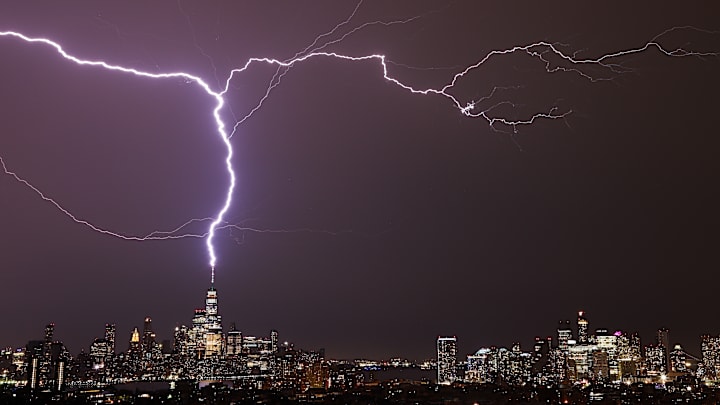On September 13, 2021, a severe thunderstorm pelted New York City with heavy rain, strong winds, and a wild lightning show. During the tempest, One World Trade Center—the Western Hemisphere’s tallest building at 1792 feet, including its antennae—was struck by several impressive bolts.
Fortunately, the lightning strikes produced amazing photos and videos rather than catastrophic, fiery destruction—thanks to the skyscraper’s sophisticated lightning protection system based on the designs of Benjamin Franklin. But did Franklin really originate the concept of a lightning rod with his famous experiment?
Kite and Key
In the late 1740s, Franklin—Founding Father, inventor, and storm chaser—began investigating whether lightning was a form of electricity, as other scientists had suggested. To test the idea, he procured a kite and attached a metal key to it with an insulating silk cord. In 1752, he flew the kite during a thunderstorm and witnessed the key attract an electrical charge, proving the theory.
Franklin started advocating for metal rods to protect buildings and the people inside them from the destructive forces of lightning. He hypothesized that an iron spire on top of a building or ship could protect it from fire by attracting the lightning’s energy and dispersing it safely. In a letter to a friend, he theorized that “the electrical fire would, I think, be drawn out of a cloud silently before it could come near enough to strike.”
For his efforts, Franklin is often thought of as the father of the lightning rod. But he might have been beaten to the idea.

The possible pre-Franklin origins of the lightning rod are vigorously debated. Around 1730, a Russian industrialist named Akinfiy Demidov built the 189-foot-tall Leaning Tower of Nevyansk in Sverdlovsk Oblast, north of Yekaterinburg. It’s topped with a metal spire that connects to metal within the building’s structure, grounding what might be considered the first known lightning rod.
It’s not clear whether Demidov intended the spire to act as such, but it could be an instance of nearly simultaneous invention.
Read More Stories About Inventions:
A version of this story was published in 2016; it has been updated for 2024.
